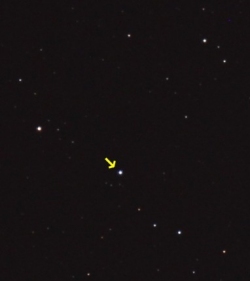On 27th May 2023. 20x30 s exposures, midpoint 03:34 UT. I estimated the SN visually as mag 11.0.
Imaged with DSLR on a 28 cm SCT operating at f/6.3. ISO 800. Cropped image. A supernova in the same galaxy occurred in 2011 (SN 2011fe). North is towards the right.

Discovered at 10th magnitude on 16th March 2021.
The nova on 12th May 2021 at 08:04 UT.Imaged (cropped) taken with DSLR with a 55 mm focal length lens. ISO 1600. 10 second exposure (non driven).North is to the top-left.
On the same date I visually estimated it as mag 5.4, using an AAVSO Chart. The nova lies 1/2° S of M52. It was later named V1405 Cas.

Alpha Orionis or Betelgeuse is the bright semi-regular variable in the NE corner of Orion.
Below: Betelgeuse 17th February 2020.Imaged with compact camera on a 5 mm camera lens. ISO 800. 15 second exposure.I visually estimated it as mag 1.7 five nights later. North is to the top-left.

Left: On the night of 22nd/23rd January 2014. 20x15 s exposures, midpoint 01:55 UT. Outside temperature -12°C. North to the top-left. Click on image for a more detailed one.
Right: 30th January 2014. 21x20 s exposures, midpoint 01:52 UT. North to the bottom-right. The SN is marked with a red bar.
Both imaged with DSLR on a 28 cm SCT operating at f/6.3. ISO 800. Cropped images.


Discovered at 6th magnitude on 14th August 2013.
Below: Nova Delphini 2013 on 16th August 2013 at 01:20 UT.Imaged with DSLR with a 55 mm focal length lens. Thin cloud was present. ISO 1600. 4 second exposure.I visually estimated it as mag 4.9 using an AAVSO Chart. North is to the top.The nova lies 6 ° NW of Alpha Del. Later named V339 Del.

Supernova 2011fe in M101, in the Pinwheel Galaxy in Ursa Major.
Left: SN 2011fe on the night of 30th/31st August 2011.15x60 s exposures, taken at 03:28 UT. Cropped image. North is towards the right.I made the magnitude to be 11.3.
Right: On the night of 16th/17st September 2011.6x60 s exposures, taken from 00:18 UT to 00.25 UT. Cropped image. North is towards the right. I estimated the SN to be mag 10.0 that night.
Click on images for more detailed ones, with markers (or an arrow) showing the position of the SN in the spiral galaxy.This is the brightest SN observed since SN1987A in the LMC.Both imaged with DSLR on a 106 mm refractor at f/5. ISO 400. Processed in AIP4WIN 2.


SN 2011dh in M51, the Whirlpool Galaxy.
Below: Supernova 2011dh on the night of 3rd/4th June 2011.Imaged with DSLR on a 106 mm refractor operating at f/8. ISO 400. 17x60 s exposures, taken from 04:26 UT to 04.51 UT. Cropped and inverted image. North to the right.
Click on image for a more detailed one, with markers showing the position of the SN.

SS Cygni is the brighest of the Dwarf Novae type of Cataclysmic Varaibles.
Below: SS Cygni in outburst on 17th January 2011.Imaged with DSLR on a 130 mm f/8 refractor. ISO 800. 15 second exposure.I visually estimated it as mag 8.2 using an AAVSO Chart. North is to the top and a little right.

The autumn constellation of Cetus, the whale, is one of the lesser known constellations. For a few weeks every year its pattern is changed when the variable star Mira becomes bright.Mira is the brighest of the Long-Period Variables and the prototype of its class. At maximum it is usually 3rd or 4th magnitude, while at minimumum it can drop to below 9th magnitude. Its average period is 331 days, butthere is a variation from cycle to cycle. Its proper name is Mira - "The Wonderful". It is a red giant star.

Above: Mira shining at 3rd magnitude in October 2010, now the third brightest star in Cetus.Imaged on 16-17th October 2010 with lens set at 28mm focal length. ISO 800. 15 second exposure.I visually estimated it as mag 2.9. Comparisons Alpha Ceti (mag 2.5) and Gamma Ceti (mag 3.5). Roll your mouse over the image to see the usual constellation pattern.

Mira shining as a 2nd magnitude object, much brighter than its average value maximum magnitude value of 3.5.
Photo taken on 17th February 2007 taken with 30 mm focal length lens.
The nova on 22nd December 1993 at 18:23 UT. Photo (cropped) taken with SLR with a 50 mm focal length lens. 3 minute exposure on Kodachrome 200. North is to the bottom. The bright star at the centre of the image Beta Cas.
On the same date I visually estimated it as mag 6.3, using an AAVSO Chart. About 3 or 4 days earlier the nova peaked at magnitude 5.3. The nova lies 1.7° W of Rho Cas. The nova was discovered on 7th December 1993. It was later named V705 Cas.
